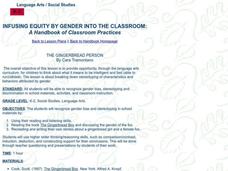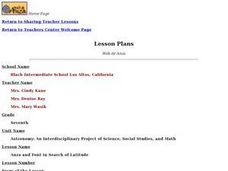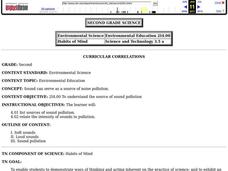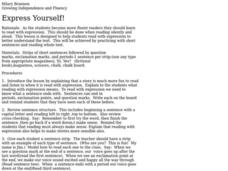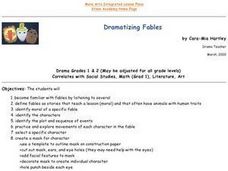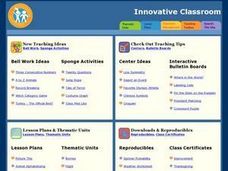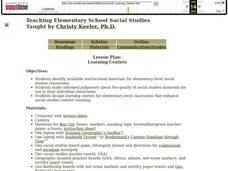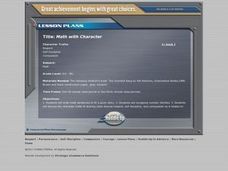Curated OER
The Gingerbread Person
Students think about what it means to be intelligent and fast (able to run)/athletic. After listening to the story, 'The Gingerbread Boy,' students write their own stories about a gingerbread girl and a female fox.
Curated OER
Rainforest 3-D Art
Third graders create a three dimensional Rainforest scene which shows five aspects of the rainforest. They orally present the scene.
Curated OER
Criteria and Constraints in Aircraft Design
Students investigate criteria and constraints for designing any aircraft. They define these terms and categorize a series of examples of both. Using the constraints and criteria set before them, they design and construct airplanes in...
Curated OER
Cotton Paper Bag Puppets
Students read book, "The Cotton in your T-Shirt," brainstorm facts about cotton, make cotton paper bag puppets, and list facts about cotton on the back.
Curated OER
Anza and Font in Search of Latitude
This is an integrated lesson that incorporates Social Studies, Science, and Mathematics. In Social Studies, 7th graders complete an online interview and complete an online worksheet about latitude of sites on the Anza trail. In Science...
Curated OER
Stand Up Bunny
Students create "stand-up bunnies" for classroom display in this early-elementary Art lesson ideal for the spring months. A bunny template and design ideas are included to aid in the teaching process of this fun and quick lesson.
Curated OER
Fish Parasite Survey
Students count nematodes, cestodes and crustaceans on approximately one-hundred and fifty fish. They fill out autopsy reports for external and internal parasites then complete and discuss guide questions to make inferences about parasite...
Curated OER
Fish Parasite Survey
Students survey and dissect as many fish as possible. They count nematodes, cestodes and crustaceans on the fish, fill out autopsy reports, and transfer data to a chalkboard data table. Students graph the results of the entire class...
Curated OER
Look Up - Birds
Students investigate the concept of birds. They identify five different types of birds and name the characteristics that make them different than other living things. Students also name the different parts of the bird and how they are...
Curated OER
Simple Machines
First graders discuss work, force, and energy. They study how work is done. Students discuss various types of work that are done. They act out how work is done. Student draw pictures of types of work they have done.
Curated OER
Habits of Mind
Second graders explore sound pollution. They discuss the various sources of sound pollution. Students relate the intensity of sounds to pollution. They create a collage of various causes of sound pollution.
Curated OER
Doctor : Open Wide And Say /o/
Students complete a variety of activities related to the short /o/ sound. As a class they recite a tongue twister, then trace and write the letter O. Students listen to a list of words and identify the words containing the short /o/...
Curated OER
Express Yourself
Students investigate the different types of sentences that are found in common usage including exclamatory, interrogative, declarative, and imperative. They examine samples of the different types of sentences and identify the name for each.
Curated OER
Building Log Cabins
Fourth graders design and create a log cabin in this lesson. They use ratios to help make dimensions of a house. They draw out how they want their house to look and gather the materials they need to complete the house. The log cabins...
Curated OER
Dramatizing Fables
Students familiarize themselves with fables by listening to several of them. They define fables. They identify the moral of a specific fable. They identify characters, plot and sequence of events. They create a mask of a character in a...
Curated OER
Makeshift Tambourines
Students use everyday materials to make their own tambourines. As a class, they play the tambourines and discover beats and rhythms. They work on creating their own song and beat and play to the rest of the class to end the lesson.
Curated OER
Story Of Silk
Students discover the use of silk found in China while conducting research using a variety of resources. They read "The Empress And The Silkworm" as a literature study to establish the context of the lesson plan. Then students unwrap a...
Curated OER
100 Day Chick Hunt
Students investigate how to count to the number 100 with the connection to using chicks as objects. They use cutouts of chicks and place them into the counting chart and recognize the different numerals while counting at the same time.
Curated OER
Disney's Mickey Mouse Clubhouse "Daisy Bo Peep"
Students watch an episode of Mickey Mouse's clubhouse, "Daisy Bo Peep". As a class, they are introduced to the proper words to describe location. They also identify the circle, square and triangle shapes and end the lesson by solving...
Curated OER
Earth Science: Create a Star Clock!
Students identify and use the starts to tell time just as people had for thousands of years. They identify the stars that appear to rise in the east and set in the west, and that those stars near the North Pole appear to go in circles...
Curated OER
What Will I Wear to School Today?
Students describe the day's weather and observe their responses as they are written on the board. They brainstorm all different types of weather and how differences in weather determine what types of clothing we wear to school each day....
Curated OER
Teaching Elementary School Social Studies
Students explore numerous instructional materials that may be used in an elementary social studies classroom. After analyzing each type of material, they discuss and make informed decisions concerning the quality and use of the material....
Curated OER
Math with Character
Students write math sentences to fit a given story. They recognize number families and discuss the character traits of a sharing and relate their feeelings and experience with sharing. The Doorbell Rang story is read and the students...
Curated OER
Make a Natural Weaving
Learners use natural materials and yarn to create weavings. In this natural weaving lesson, students find large branches to act as the loom, use other natural objects to act as designs within the weave, and use fine motor skills to wrap...


